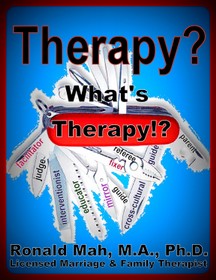1. Therapist Is... Therapy Is... - RonaldMah
Ronald Mah, M.A., Ph.D.

Licensed Marriage & Family Therapist,
Consultant/Trainer/Author
Main menu:
1. Therapist Is... Therapy Is...
Therapist Resources > Therapy Books > Therapy! What's Therapy?

Therapy? What's Therapy!?
Chapter 1: THE THERAPIST IS… and THERAPY IS…
by Ronald Mah

What is therapy? What does the therapist do? What is individual, couple, or family therapy? What does the therapist do? The therapist has varied roles during therapy as therapy evolves. The roles further vary in various theoretical and therapeutic orientations. What should the therapist know? How do therapy and the therapist work? For this client or that client, this couple or that couple, or family? For Vee? Carson? For them as a couple? Or, for the family? With this issue or that issue? The answer is the classic therapy answer- "It depends!" There can be found some general guidelines for effective therapy. Beginning counselors, counselor educators, and clinical supervisors concur about twenty seemingly universal aspects for effective therapy in Fontaine and Hammond's article (1994).
Monitoring Personal Process
1. Trust yourself. Your reactions are a reflection of how others experience the client. Use that information.2. It is not necessary for you to protect clients- they are not as fragile as you may believe.3. Don't worry about whether your client likes you.4. Take the risk of trying something new. Go outside of your comfort zone.5. It is not your responsibility to solve the client's problems.6. Be open to all sources of information, and actively challenge your own impressions.7. Compare. Use your frame of reference of what is "normal" to assess your client's behavior.8. Always have your client's interests at heart. Ask yourself whose needs would be met if you said or did thus and so.9. Carefully self-monitor your responses to the client, particularly the strong emotional responses you might have in either direction.
Client Process
10. Behavior speaks more loudly than words.11. It's okay if your client is uncomfortable at times.12. Don't let a client hide behind other people. Have them talk about themselves and their reactions.13. What's good for one client may not be good for another, even if they share the same issue.14. General statements about relationships and former counselors usually imply something about the client's relationship with you.
Moving the Therapy Process Forward
15. Many times clients are aware of their issues and avoid talking about them. Don't collude in this with your client.16. When discussing events of interest in therapy, remember three Cs: Be concrete in getting specific details about the events, ask about the context of the event, and look for conceptual themes in the client's stories about his or her life.17. Attend to the structural aspects of the counseling process. These can be summarized by the concepts of time, windows, and bridges. (timing, topic openings, connecting topics).18. Constantly ask yourself why. Why does this issue arise now? Why in this fashion? Why am I following up on this topic and not another? Why? Why?19. Share your perceptions of and insights about your client's behavior with them. This information is valuable feedback.20. You do not have to address every issue or discrepancy you see- but do not lose it either. File it for use later (page 222-225)
Within every approach to therapy, these maxims often are implied if not presented outright as necessary to engage in the therapeutic process or to understand it. A theme in these maxims is for the therapist to be attentive and respectful of clients, their processes, and needs. Another important theme is for the therapist to be aware of and responsible for personal own processes as they strongly affect therapy. Peluso and Macintosh (2007) explained the basic model of Albert Adler's therapy. The model is similar to many other therapies and reflects themes of attention and respect of clients and of the therapist's processes from establishing rapport to the mutual agreement to terminate therapy as goals are achieved. The four-stage model is (a) relationship building, (b) investigation, (c) interpretation, and (d) reorientation. "In the relationship building stage, it is incumbent upon the therapist to create a solid therapeutic alliance with the couple, demonstrate fairness in dealing with both partners, and provide a secure base from which to work. In the next phase, investigation, lifestyle analysis of each person is conducted and includes an examination of family-of-origin dynamics (psychological birth order, family atmosphere) and early recollections. From this analysis, the couple's private logic and goals can be determined. Interpretation allows the therapist to juxtapose the styles of life of both partners and reflect how the dynamics and behavioral choices of each partner are contributing to the disruption in the marital system. The insight into the couple's relationship allows the therapist to begin interventions and help the couple to make some different choices in relating to one another. The reorientation phase is the aspect of therapy where the couple, under the guidance and encouragement of the therapist, creates an action plan based on the result of the lifestyle assessment and in light of the presenting problem. The couple makes specific changes in their interactions with each other and evaluates the effect on the relationship. Termination is usually based upon mutual agreement between clients and therapist once the main goals of therapy have been accomplished" (page 249-50).
Since the therapist executes all four stages of therapy, he or she are required to adapt to the demands of each stage. The therapist can build rapport by initially presenting him or herself as sensitive, caring, experienced, and wise. Subsequently, the therapist becomes the investigator, interpreter, and finally, guide to new client worlds. Note the similarities and nuanced differences as the therapist practices from another theoretical orientation and adapt the work for the three stages of Emotionally Focused Therapy.
Stages of Emotionally Focused Therapy for Couples Stage
1. Assessment and
Delineation ofProblematic Cycles/
De-escalation
II. Reengagement/
Softening
III. Consolidation
Step/Description
1. Create an alliance and delineate conflict issues in the struggle.2. Identify the negative interactional cycle.3. Access unacknowledged feelings and attachment needs.4. Reframe problem in terms of underlying emotions and needs.5. Promote identification with disowned needs and aspects of self.6. Promote acceptance of partner's experience.7. Facilitate the expression of unmet needs and wants.8. Facilitate the emergence of new solutions.9. Consolidate new positions. (page 252)
Assessor, Psychological Detective, Accessor, Reframer, Promoter, Facilitator, and Consolidator! Roles may come from a theoretical orientation or may be chosen by the therapist and/or evoked by client's actions. Some roles are appropriate while others may be appropriate transitionally or may never be appropriate. The therapist who adapts with clinical fluidity to meet and match the therapeutic situation can meet the client's needs as they evolve through therapy. The therapist who take the role of marriage (or some other value-based model) defender and enforcer is not practicing a role defined by his or her license, but make decisions for the client motivated by personal but not necessarily, the client's convictions, including religious convictions. Lum (2002) says there can be "four areas of perceiving the world: how we define a relationship, a person, an event, and attitudes toward change… How therapists view clients will affect how therapeutic relationships will develop. When therapists view clients as victims, this will disempower and discourage clients from accessing their own inner resources to deal with their situation… The Satir model encourages therapists to become aware of, and to acknowledge, and change any beliefs that are negatively affecting their ability to congruently process their clients" (page 187). The therapist who has defined a marriage as religiously sanctified and perpetual or defined some other behaviors as righteous will not congruently process the client's words, feelings, and actions. Such a therapist will amplify, minimize, or disregard client's communications as he or she fits or not fits with the therapist's view of sacrosanct marriage, righteous behavior, or healthy functioning.

